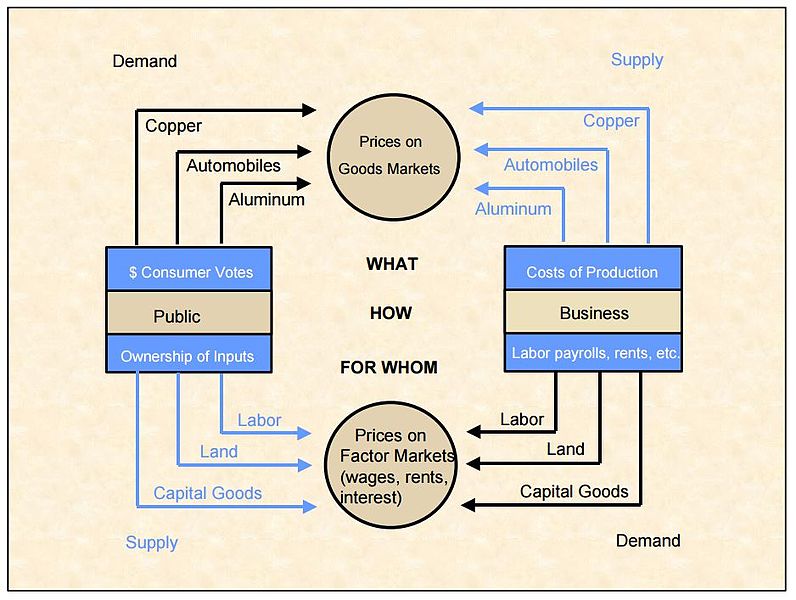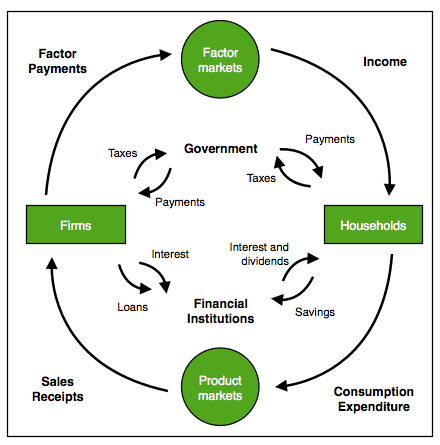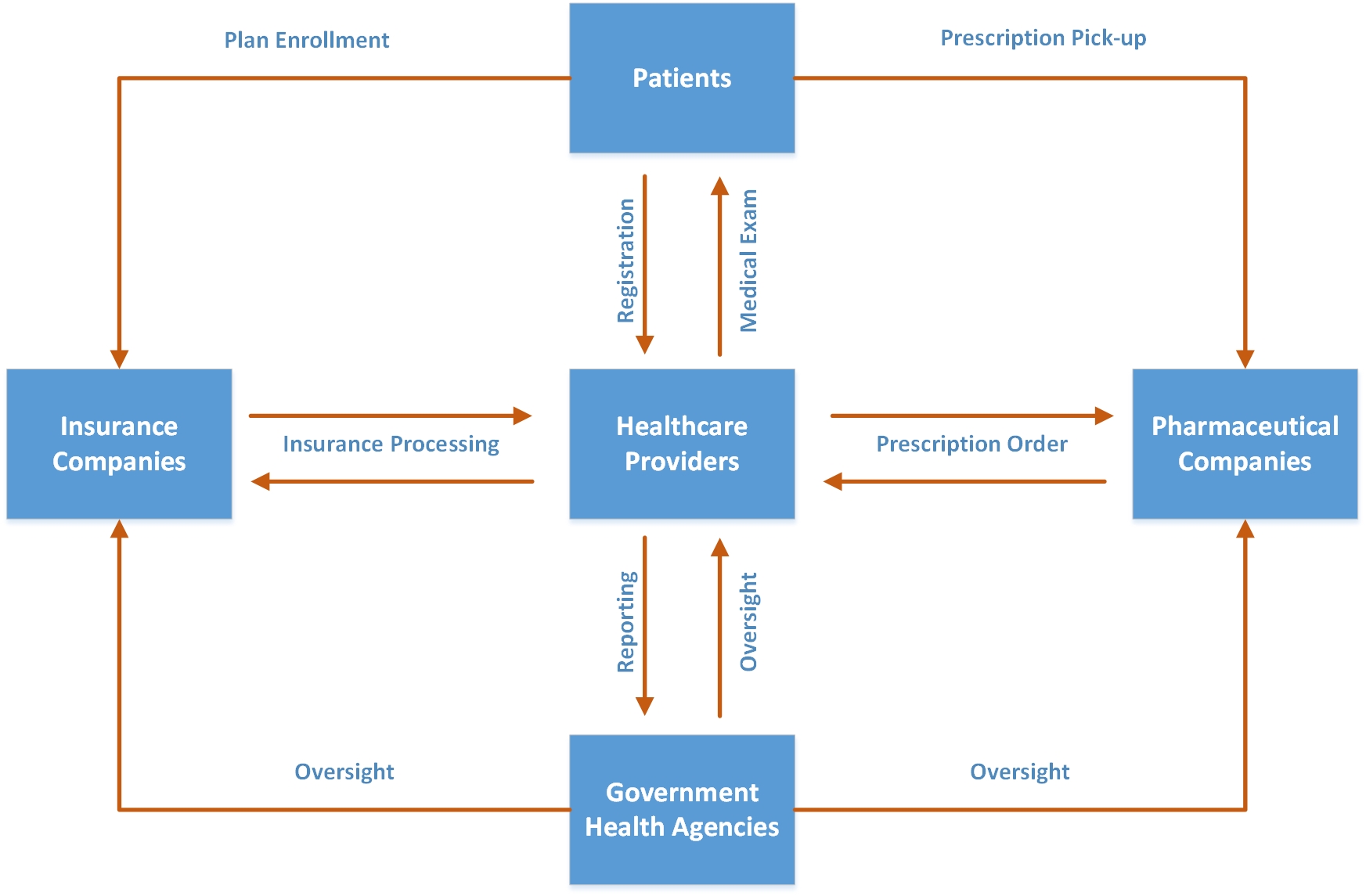Introduction
In the intricate world of business analysis, understanding the complex interactions between various economic agents is crucial for making informed decisions. One tool that plays a pivotal role in comprehending these interactions is the Circular Flow Diagram or CFD. Originating from the field of economics, this visual representation has found its way into the toolkit of business analysts, offering a holistic view of how money, goods, and services circulate within a vertical industry or within an organization. In this article, we delve into the essence of the Circular Flow Diagram and explore its applications in the realm of business and systems analysis.

Understanding the Circular Flow Diagram
The Circular Flow Diagram is a graphical representation originally created to show the flow of money, goods, and services within an economy. At its core, it illustrates the transactions between households, businesses, government, and international players. The diagram typically consists of two main sectors – the household sector and the business sector – interconnected by flows of money, goods, and services.
-
Households - In the Circular Flow Diagram, households represent individual consumers or families. These entities supply factors of production, such as labor and capital, to businesses. In return, they receive income in the form of wages, rent, and profit.
-
Businesses - The business sector encompasses all the firms and enterprises involved in the production of goods and services. Businesses use the factors of production supplied by households to create products. In exchange for these factors, businesses pay income to households.
-
Government - The government sector is introduced to account for the various roles played by the government in the economy. This includes taxation, government spending, and transfer payments. The government receives revenue from households and businesses and, in turn, injects money back into the economy through spending.
-
International Players - The external sector involves transactions with the rest of the world. It includes exports and imports of goods and services. The Circular Flow Diagram incorporates the flow of money between the domestic economy and the global economy.

Image source: Wikimedia Circular Flow Diagram under CC BY-SA 3.0
CFD Applications in General Business Analysis
Business analysts can utilize the Circular Flow Diagram as a valuable tool when performing enterprise analysis of an organization or when analyzing the broader ecosystem of their organization. Here are some of the activities which would benefit from employing a CFD:
-
Identifying Economic Relationships - The Circular Flow Diagram provides a comprehensive overview of the economic relationships between different sectors. Business analysts can use this tool to identify dependencies and connections, enabling them to assess how changes in one sector may impact others. For example, an increase in consumer spending (households) can lead to increased production by businesses.
-
Forecasting Economic Trends - By analyzing the circular flow, business analysts can gain insights into current economic trends and make informed predictions about future developments. For instance, if there is an increase in government spending, it may stimulate economic activity, affecting production and consumption patterns.
-
Market Analysis - For businesses looking to enter or expand in a particular market, the Circular Flow Diagram aids in understanding the dynamics of that market. It allows analysts to assess the purchasing power of households, the demand for goods and services, and the overall economic environment.
-
Supply Chain Management - Businesses operate within a network of suppliers, producers, and distributors. The Circular Flow Diagram can be adapted to represent the flow of goods and services along the supply chain. This visualization helps in optimizing supply chain management, identifying potential bottlenecks, and improving overall efficiency.
CFD Applications in Systems Analysis
A systems analyst can leverage the Circular Flow Diagram as a powerful tool to analyze and understand the flow of information, resources, and processes within a system. An SA can use the CFD as a visual representation to gain insights into the inner workings of a system, identify areas for improvement, and communicate complex system structures to stakeholders. This holistic view is instrumental in making informed decisions and driving effective changes within the analyzed system.
Here's a couple of areas where a systems analyst might benefit from using a Circular Flow Diagram:
-
System Boundary Definition - The Circular Flow Diagram helps a systems analyst define the boundaries of the system under consideration. By identifying the main components (analogous to economic sectors in the traditional Circular Flow Diagram), such as users, processes, data, and external entities, the analyst can clearly delineate the scope of the system.
-
Identifying Components and Interactions - Within the system boundary, a systems analyst can use the Circular Flow Diagram to identify key components and their interactions. This includes understanding how data, information, and processes flow between different elements of the system. For example, if the system involves multiple departments in an organization, the CFD can illustrate how information moves between these departments.
-
Input-Output Analysis - Similar to the economic concept in the traditional Circular Flow Diagram, a systems analyst can perform an input-output analysis. This involves mapping the inputs (such as data, requests, or requirements) that enter the system and the corresponding outputs (results, reports, or outcomes) produced by the system. Understanding this flow is crucial for optimizing processes and ensuring that the system meets its objectives.
CFD Example for Healthcare Domain
Let's explore a Circular Flow Diagram example in the context of the healthcare industry, demonstrating how an analyst could use it to analyze the flow of information, resources, and processes within a healthcare system.

Diagram Components
-
Patients - Represented as a key component, patients are the primary users of healthcare services.
-
Healthcare Providers - Include hospitals, clinics, physicians, nurses, and other healthcare professionals.
-
Insurance Companies - Represent entities responsible for handling financial transactions and reimbursements.
-
Pharmaceutical Companies - Involved in the production and distribution of medications.
-
Government Health Agencies - Entities responsible for regulatory oversight and public health initiatives.
Flow of Information and Processes
-
Patient Registration - The process begins with patients registering for healthcare services, capturing their demographic and insurance information.
-
Medical Exam - Patients interact with healthcare providers for medical consultations, examinations, and diagnoses.
-
Prescription and Medication - If necessary, prescriptions are provided, and patients interact with pharmacies or pharmaceutical companies to obtain medications.
-
Insurance Processing - Healthcare providers submit claims to insurance companies for reimbursement, and patients may also interact with insurance companies for coverage-related queries.
-
Government Oversight - Regulatory agencies oversee the compliance of healthcare providers and pharmaceutical companies with healthcare standards and regulations.
Input-Output Analysis
-
Inputs - Patient information, medical resources, financial transactions, regulations, and medications.
-
Outputs - Diagnoses, prescriptions, treatments, insurance claims, regulatory compliance reports, and public health initiatives.
Conclusion
Circular Flow Diagrams serve as powerful visual tools for both business and systems analysts. For business analysts, these diagrams provide a comprehensive representation of economic interactions, enabling insights into market dynamics, forecasting trends, and evaluating policy impacts. Meanwhile, systems analysts utilize CFDs to visually analyze and optimize the flow of information, resources, and processes within a system. These diagrams help identify dependencies, streamline operations, and communicate complex system structures to stakeholders. In summary, Circular Flow Diagrams enhance the analytical capabilities of both business and systems analysts, offering a holistic view that aids in decision-making, process optimization, and effective communication.
Author: Morgan Masters, Business Analyst, Modern Analyst Media LLC
Morgan Masters is Business Analyst and Staff Writer at ModernAnalyst.com, the premier community and resource portal for business analysts. Business analysis resources such as articles, blogs, templates, forums, books, along with a thriving business analyst community can be found at http://www.ModernAnalyst.com